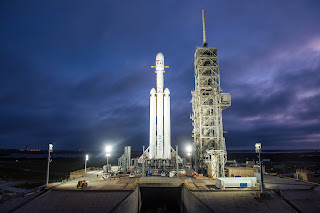 |
| "Of Course I Still Love You" positioned in the Atlantic Photo // SpaceX |
 |
| Falcon Heavy side boosters landing at LZ-1 & LZ-2 Photo // SpaceX |
 |
| "Of Course I Still Love You" positioned in the Atlantic Photo // SpaceX |
 |
| Falcon Heavy side boosters landing at LZ-1 & LZ-2 Photo // SpaceX |
 |
SpaceX Crew Dragon recovery trainer on Go Searcher Photo // Ryan Bale |
 |
| Falcon Heavy roars to life Photo // Ryan Bale - Spaceflight News |
 |
| Falcon Heavy side boosters falling toward LZ-1 and LZ-2 Photo: Ryan Bale // Spaceflight News |
 |
| Falcon Heavy punching through the clouds Photo // Ryan Bale - Spaceflight News |
 |
| "Starman" in orbit around Earth in a Tesla roadster Photo // SpaceX |
 Tomorrow afternoon at 1:30pm EST, SpaceX plans to launch their long-awaited Falcon Heavy rocket from Historic Launch Complex 39A (LC-39A). The 3-hour launch window extends from 1:30pm-4:30pm EST with a backup window on Wednesday.
Tomorrow afternoon at 1:30pm EST, SpaceX plans to launch their long-awaited Falcon Heavy rocket from Historic Launch Complex 39A (LC-39A). The 3-hour launch window extends from 1:30pm-4:30pm EST with a backup window on Wednesday.  The Falcon Heavy is comprised of 3 Falcon 9 cores strapped together. It isn't as simple as that - the core stage had to be redesigned to withstand the extreme forces being put onto it during flight from the side cores. The side cores have the new titanium grid fins which help the boosters steer down to the landing site at Cape Canaveral. The three cores total 27 Merlin engines and produce approximately 5 Million pounds of thrust at liftoff.
The Falcon Heavy is comprised of 3 Falcon 9 cores strapped together. It isn't as simple as that - the core stage had to be redesigned to withstand the extreme forces being put onto it during flight from the side cores. The side cores have the new titanium grid fins which help the boosters steer down to the landing site at Cape Canaveral. The three cores total 27 Merlin engines and produce approximately 5 Million pounds of thrust at liftoff. |
| Falcon 9 first stage floating in the Atlantic Photo // SpaceX |
 |
| Falcon 9 launching GovSat-1 Photo // SpaceX |
 |
| Falcon 9 GovSat-1 sitting on the launch pad before yesterday's launch attempt Photo // SpaceX |
 |
| GovSat-1 satellite Photo // OrbitalATK |
 |
| Falcon Heavy firing at LC-39A Photo // SpaceX |
 |
| Electron "Still Testing" launching Photo // Rocket Lab |
 |
| Engineers working on Electron Photo // Rocket Lab |
 |
| The Atlas V at SLC-40 during sunset Photo // ULA |
 |
| Atlas V rolled onto SLC-41 Photo // ULA |
 |
| The Atlas V rolling out to the pad Photo // ULA |
 |
| Flight-proven Falcon 9 launching the CRS-13 mission from SLC-40 Photo // SpaceX |
 |
| The CRS-13 Dragon Spacecraft after recovery by SpaceX Photo // SpaceX |
 |
| The Delta IV clears the tower after liftoff Photo // ULA |
 |
| Delta IV leaps off the launch pad after igniting the two SRBs Photo//ULA |
 |
| Delta IV illuminated by lights on the launch pad after rollback Photo // ULA |
 |
| Technicians point out details on SBIRS GEO-4 prior to final encapsulation at CCAFS, FL on Jan. 9th Photo // Lockheed Martin Space Systems, Colorado |
 |
| Unique, low angle image of SBIRS GEO-4 after final encapsulation Photo // Lockheed Martin Space Systems, Colorado |
 |
| An Atlas V being raised vertical at SLC-41 Photo // United Launch Alliance |
 |
| Falcon Heavy raised vertical at LC-39A for the first time Photo // SpaceX |
 |
| Falcon Heavy being rolled out January 8th Photo // Elliott Skeer - Twitter |
 |
| Elon Musk's Tesla Roadster being encapsulated Photo // SpaceX |
 |
| Long-Exposure of the launch and landing Credit: Michael Seeley // We Report Space |
 |
| Falcon Heavy vertical at LC-39A for the first time Credit: SpaceX |
 |
| Falcon 9 with Zuma on top at LC-39A Photo Credit // SpaceX |
"Of Course I Still Love You" positioned in the Atlantic Photo // SpaceX To this date, SpaceX currently has 2 droneships to lan...
